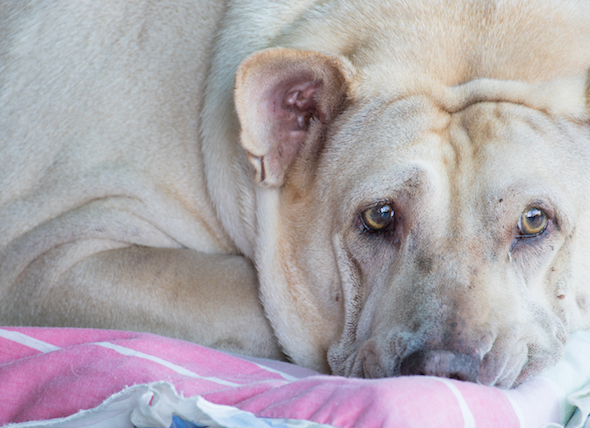

Mast cells are cells that reside in the connective tissues, especially those vessels and nerves that are closest to the external surfaces (e.g., skin, lungs, nose, mouth). Their primary functions include defense against parasitic infestations, tissue repair, and the formation of new blood vessels (angiogenesis). They are also associated with allergic reactions, since they contain several types of dark granules made up of various chemicals, including histamine and heparin, serving biologically to modify immune reactions and inflammation. Mast cells are derived from the bone marrow, and can be found in various tissues throughout the body.
Mast cell tumors (or mastocytomas) are graded according to their location in the skin, presence of inflammation, and how well they are differentiated. Grade 1 cells are well differentiated with a low potential for metastasis; Grade 2 cells are intermediately differentiated with a potential for locally invasive metastasis; and Grade 3 cells are poorly differentiated or undifferentiated with a high potential for metastasis. Differentiation is a determination of how much a particular tumor cell looks like a normal cell; the more differentiated, the more like the normal cell. In general, the more differentiated the mast cell tumor is, the better the prognosis is.
Boxers, bulldogs, pugs, and Boston terriers appear to be more susceptible to mast cell tumors than other breeds. The mean age for the development of this condition is eight years in dogs, though it has been reported in animals less than one year of age.
Symptoms may be dependent on the location and grade of the tumor.
Symptoms are also dependent on the stage of the disease:
Unknown
You will need to give a thorough history of your dog's health, including a background history of symptoms. The history you provide may give your veterinarian clues as to which organs are being affected.
The most important preliminary diagnostic test will be an examination of the cells taken from one of the tumors. This will be performed with a fine needle aspirate and will determine the presence of an abnormal amount of mast cells in the blood. A surgical tissue biopsy will be necessary for definitive identification of both the grade of the cells occupying the mass, and the stage the disease is in. Additionally, your veterinarian may examine a sample from a draining lymph node, from the bone marrow, or from the kidney and spleen. X-ray and ultrasound images of the chest and abdomen will also be component of determining the exact location and stage of the tumor's development.
Manipulation of the tumor may result in the release of histamines from the tumor due to the mast cells releasing from the tumor into the blood stream. Antihistamines may be prescribed to alleviate some of the symptoms related to this effect. This same behavior can come into play as a result of surgical intervention; antihistamines will be used under the circumstances, as a large release of histamines on the body can have a drastic effect on the organs.
Aggressive surgical removal of the mast cell tumor and surrounding tissue is generally the treatment of choice. A microscopic evaluation of the surgically removed tissue is essential for determining the success of the surgical removal and for predicting the biological behavior of the tumor; if tumor cells extend too close to the surgical margins, your veterinarian will need to perform a more aggressive surgery as soon as possible. In case of lymph-node involvement with no generalized involvement in other parts of the body, aggressive surgical removal of the affected lymph node(s) and the primary tumor will be required; follow-up chemotherapy is useful for the prevention of further metastasis of tumor cells.
If the primary tumor and/or affected lymph nodes cannot be excised entirely, chemotherapy may have short-term benefit, with some respite from the effects of the disease. Your dog may have a brief recovery period of one to four months.
If there is a generalized spread of tumor cells to other parts of the body, surgical removal of the primary tumor and affected lymph nodes are of minimal benefit, but chemotherapy may have short-term benefit (less than 2 months). Radiation therapy is a good treatment option for mast cell tumor of the skin in a location that does not allow aggressive surgical removal; if possible, surgery will be performed before radiation therapy is given to reduce the tumor to a microscopic volume; tumors on an extremity often respond better than tumors located on the trunk.
Your veterinarian will want to microscopically evaluate any new masses and evaluate the lymph nodes at regular intervals in order to detect spread of Grade 2 or Grade 3 tumors. Your doctor will also want to perform a complete blood count at regular intervals if your dog is receiving chemotherapy. Immunity can be affected by cancer fighting drugs, so it will be important to protect your dog from illness and communicable diseases during this period, as well as sticking closely to a healthy, immune boosting diet.
 Excess Magnesium in the Blood in Dogs
Hypermagnesemia in Dogs
Magnesium is found mostly
Excess Magnesium in the Blood in Dogs
Hypermagnesemia in Dogs
Magnesium is found mostly
 Water on the Brain in Dogs
Hydrocephalus in Dogs
Hydrocephalus is an expansi
Water on the Brain in Dogs
Hydrocephalus in Dogs
Hydrocephalus is an expansi
 Painful Abdomen in Dogs
Peritonitis in Dogs
Peritonitis is often associat
Painful Abdomen in Dogs
Peritonitis in Dogs
Peritonitis is often associat
 Kidney Disease in Dogs
Fanconi Syndrome in Dogs
Fanconi syndrome
Kidney Disease in Dogs
Fanconi Syndrome in Dogs
Fanconi syndrome
 Spinal and Vertebral Birth Defects in Dogs
Congenital Spinal and Vertebral Malformations in Dogs
&n
Spinal and Vertebral Birth Defects in Dogs
Congenital Spinal and Vertebral Malformations in Dogs
&n
Copyright © 2005-2016 Pet Information All Rights Reserved
Contact us: www162date@outlook.com